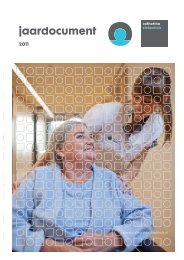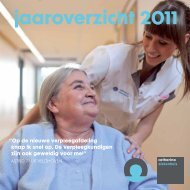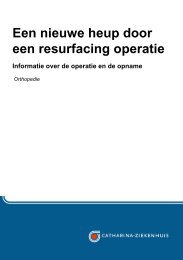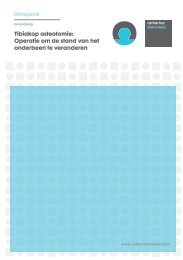Wetenschappelijk jaaroverzicht 2012 - Catharina Ziekenhuis
Wetenschappelijk jaaroverzicht 2012 - Catharina Ziekenhuis
Wetenschappelijk jaaroverzicht 2012 - Catharina Ziekenhuis
Create successful ePaper yourself
Turn your PDF publications into a flip-book with our unique Google optimized e-Paper software.
RESULTS: For the majority of biomarkers, we observed lower levels in the healthy control<br />
group compared with patients with stable angina who underwent coronary catheterization.<br />
We found no difference for any of the selected biomarkers between patients with a positive<br />
FFR (d 0.75) and negative FFR (>0.80). We observed no relationship between the<br />
investigated biomarkers and FSS.<br />
CONCLUSION: The presence of local atherosclerotic lesions that result in inducible<br />
myocardial ischemia as measured by FFR in patients with stable coronary artery disease is<br />
not associated with increased plasma levels of IL-6, IL-8 and TNF- or increased expression of<br />
TLR2 and TLR4, CD11b, CD62L and CD14 on circulating leukocytes.<br />
Impactfactor: --<br />
Sels JE<br />
Functional measurement of coronary stenosis<br />
Pijls NH*, Sels JW*<br />
J Am Coll Cardiol. <strong>2012</strong> Mar 20;59(12):1045-57<br />
Voor abstract zie: Cardiologie - Pijls NH<br />
Impactfactor: 14.156<br />
Tonino WA<br />
Fractional flow reserve-guided PCI versus medical therapy in stable coronary disease<br />
De Bruyne B, Pijls NH*, Kalesan B, Barbato E, Tonino PA*, Piroth Z, Jagic N, Möbius-<br />
Winkler S, Rioufol G, Witt N, Kala P, MacCarthy P, Engström T, Oldroyd KG, Mavromatis<br />
K, Manoharan G, Verlee P, Frobert O, Curzen N, Johnson JB, Jüni P, Fearon WF; FAME 2<br />
Trial Investigators<br />
N Engl J Med. <strong>2012</strong> Sep 13;367(11):991-1001<br />
Voor abstract zie: Cardiologie - Pijls NH<br />
Impactfactor: 53.298<br />
Tonino WA<br />
The impact of sex differences on fractional flow reserve-guided percutaneous<br />
coronary intervention: a FAME (Fractional Flow Reserve Versus Angiography for<br />
Multivessel Evaluation) substudy<br />
Kim HS, Tonino PA*, Bruyne B de, Yong AS, Tremmel JA, Pijls NH*, Fearon WF; FAME<br />
Study Investigators<br />
JACC Cardiovasc Interv. <strong>2012</strong> Oct;5(10):1037-42<br />
OBJECTIVES: This study sought to evaluate the impact of sex differences on fractional flow<br />
reserve (FFR)-guided percutaneous coronary intervention (PCI).<br />
BACKGROUND: The FAME (Fractional Flow Reserve Versus Angiography for Multivessel<br />
Evaluation) study demonstrated that FFR-guided PCI improves outcomes compared with an<br />
angiography-guided strategy. The role of FFR-guided PCI in women versus men has not been<br />
evaluated.<br />
METHODS: We analyzed 2-year data from the FAME study in the 744 men and 261 women<br />
with multivessel coronary disease, who were randomized to angiography- or FFR-guided PCI.<br />
Statistical comparisons based on sex were stratified by treatment method.<br />
RESULTS: Although women were older and had significantly higher rates of hypertension<br />
than men did, there were no differences in the rates of major adverse cardiac events (20.3%<br />
vs. 20.2%, p = 0.923) and its individual components at 2 years. FFR values were significantly<br />
higher in women than in men (0.75 ± 0.18 vs. 0.71 ± 0.17, p = 0.001). The proportion of<br />
51
















